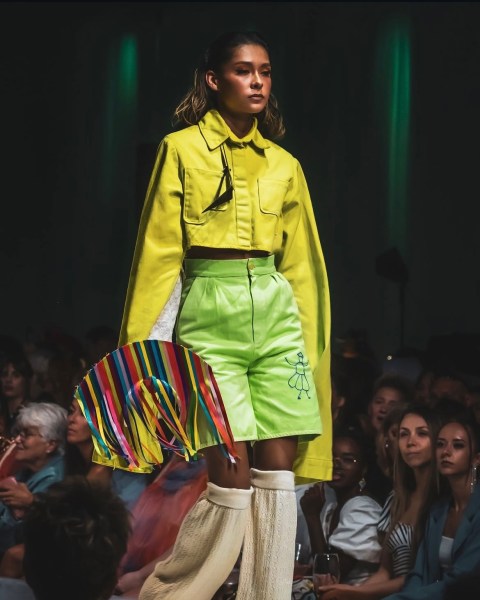Each Fall, as fashion weeks descend across New York, London, Milan, and Paris, the runways become a global mirror of the present moment forecasting next season’s trends while exposing the industry’s shifting values and contradictions around innovation.
In recent years, ideas of sustainability, slow fashion, sizing, and gender-fluid inclusivity have gained prominence yet meaningful progress has lagged. Barriers to access persist for marginalized creators, revealing how far the fashion industry still has to go in turning conversation into action.
Acclaimed designers like Willy Chavarria have been instrumental in advancing Latine visibility and recognition, yet Indigenous fashion still faces major blind spots.
Within the industry, Indigenous design is often appropriated and modeled on non-Indigenous people without credit or permission from the communities it draws from. Additionally, it’s often reduced to mere “handicraft” rather than recognized as art and design equal in skill to Western couture– all while those same communities continue to face discrimination and economic hardship. Amid these inequities, Indigenous designers are forging the shift toward ethical, self-defined representation embodying long-standing creativity and values the industry lauds as aspirational ideals.
This year marked several milestones for Indigenous representation with Jamie Okuma becoming the first Indigenous designer featured on the official NYFW schedule, while the Arts Hearts Fashion runway show also spotlit Indigenous creators. Most notably, the first Indigenous New York Fashion Week, produced by Relative Arts in the heart of Lenapehoking, epitomized this transformative shift. The event brought together Indigenous fashion artists and designers from across North, Central, and South America, (a.k.a. Turtle Island and Abya Yala) challenging divisive colonial borders by reviving the spirit of ancestral trade posts and routes that once connected Indigenous nations. Together, they honored diverse expressions through contemporary Indigenous fashion as an act of resilience and cultural renewal.
We spoke with seven Indigenous designers throughout the Americas about their collections, philosophies, and visions for the future–exploring how they’re redefining what it means to be recognized as creators shaping fashion’s evolution.
1
Pacha Arts
The Arcentales-Cajas family business from the Kichwa Peguche community of Northern Ecuador, carries four generations of textile knowledge descended from Rosa Lema Cotacachi (Mamá Rosa), one of the first Kichwa diplomatic ambassadors to the United States. Their brand, Pacha Indigenous Arts Collection is rebuilding trade networks that reconnect Indigenous communities interrupted by borders while reimagining fashion beyond Eurocentric frames.
“I like to propose concepts that reference traditional silhouettes and geometry without directly using designs that are specific to a particular community, to ensure Indigenous identities aren’t folklorized without being mindful of how sovereignty is returned back to the communities,” designer Kinoo Arcentales-Cajas tells Remezcla.
Their latest collection, Kawsanki, meaning “living”, is guided by Andean cosmology: Hanan Pacha, Ukhu Pacha, and Kay Pacha—under, inner, and upper worlds—serving as portals for ancestral knowledge, present guardianship, and Indigenous futurism. Emerging from the void, Yanas are visualized through the clothing as protectors and mirrors of self through time; personifying cyclical/spiral transition through time and complementary duality.
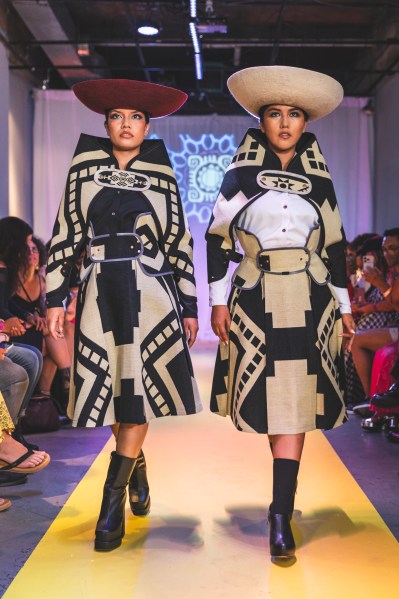
2
Josh Tafoya
In the collection Bruja, Josh Tafoya, a Genízaro, Chicano, and Spanish textile artist from Rancho de Taos, NM, explores the complex entanglement of Catholic ritual, Indigenous Southwestern traditions, and queer identity. Drawing on a family lineage of weaving with churro sheep wool, Tafoya combines handwoven fabrics, raffia, rosaries, and brocades into garments that oscillate between ancestral reverence and pointed critique.
The collection embodies the emotional tension of syncretism and the liminal spaces within identities that often overlap yet can remain in conflict. Inspirations from adobe churches appear alongside Indigenous weaving motifs as bold provocations, culminating in, Holy Joto, which subverts the weaponized f-slur through an expletive Jesus motif.
“Catholicism is so rooted in our history and traditions that I can’t disengage that aspect from myself or the community,” Tafoya explains. “For me, it’s about honoring that while simultaneously making fun of it a little, since it’s politically controversial.” As he describes, Bruja is “storytelling I’m trying to express outwards– to harness energy and flow into clothing and to spark the conversations and feelings that go with them.”
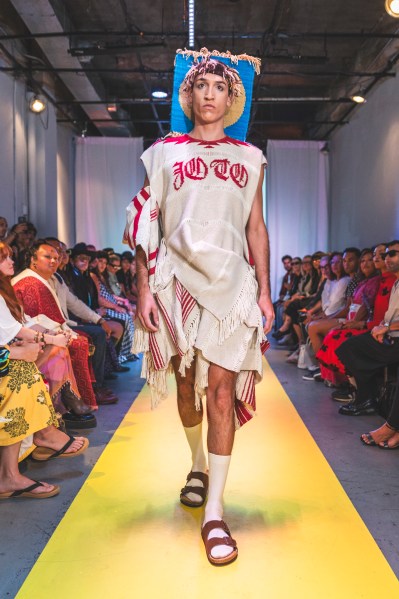
3
Kene Kaya
Founded on principles of equity and sustainable development, Kené Kaya is dedicated to preserving the cultural legacy of the Shipibo-Konibo community living along Perú’s Ucayalí River.
Its latest collection in collaboration with the Shinan Imabo collective reflected this mission through Amor Ancestral which showcased at the Arts Hearts Fashion show. Kéne-geometric patterned textiles—hand-painted with natural dyes, embroidered, and woven—were transformed into wearable art and cut minimally out of respect for the spiritual cloth. Each piece carries the vision of its creator, with artists such as Olivia Silvano, Delia Pizarro, Dorris Sanchez, and Salome Maynas given full creative freedom.
Founder and designer Alessandra Durand explains, “I’m an outspoken advocate of ethical collaboration models…rather than operating on hierarchical, paternalistic structures, I wanted to generate a horizontal model where artisans are treated as mutual co-creators, fostering income opportunities while honoring ancestral traditions.”
While their work is celebrated abroad as cultural patrimony, Shipibo-Konibo communities continue to face discrimination and lack the protections needed to sustain their traditions. Through supporting bilingual education programs in Lima and artistic advocacy that bring their textile art to global platforms, Kené Kaya places the community at the center, moving beyond symbolic recognition toward creating tangible change.
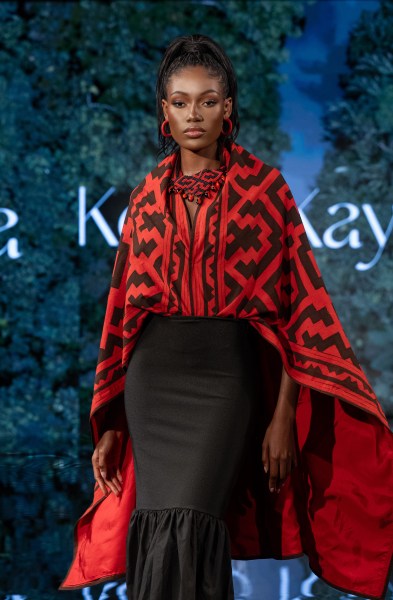
4
EMME Studio
After gaining early recognition on Project Runway Season 13, which led to EMME Studio being carried by Lord & Taylor, Puyallup designer Korina Emmerich from the Coast Salish territory in Oregon recognized the contradictions between ethical production and commercial fashion. In response, she shifted toward made-to-order, sustainable work that values collaboration and storytelling over industry pace.
That ethos shaped her costume design for The Body of Malinxe, a contemporary opera by Diné-Chicana performance artist Autumn Chacón and White Mountain Apache musician Laura Ortman, which reimagines the tragic story of the Nahua woman often conflated with the La Llorona myth through an Indigenous futurist lens. Emmerich’s collection channels grief, discomfort, hope, and resilience through sequined and beaded fabrics that shimmer like tears and river water under stage lighting. Upcycled sound wires layered over gauzy textiles honor Chacón’s experimental sonic practice, while El Techichi ‘s gender neutral jewelry by Ñuu’savi Oaxacan artist Omar Monroy reinforces southwestern continuity and cross-cultural Indigenous solidarity.
Presented as an immersive performance, the show blurred art, music, and fashion, furthered by casting diverse artists instead of traditional models. “It was important to show non-uniform, dynamic figures rather than the static industry standard models by curating unique people and personalities who help tell the story through the clothes,” Emmerich tells Remezcla. “Representing the diversity of Indigenous people in this urban [NYC] setting, on Lenape territory, should never be ignored and it should be celebrated.”
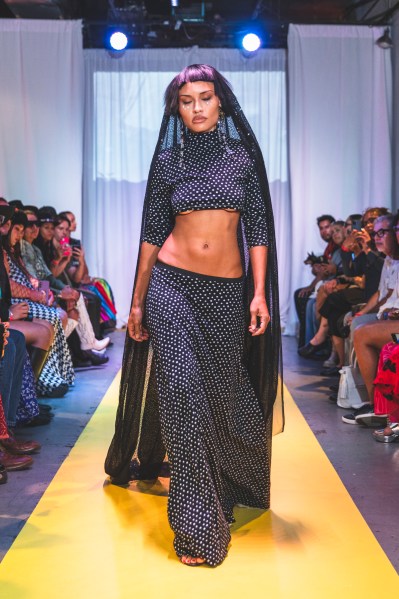
5
Hakhu
Hakhu, meaning “let’s go”, emerged as a collective where design became both a means of supporting Indigenous women’s livelihoods and a defense of territory in the Ecuadorian Amazon against extractive oil and mining industries. What began with jewelry and handicrafts made by women from the Serena community has grown into ready-to-wear clothing created through workshops where they transform their drawings of animals, plants, and ancestral symbols into embroidery and textiles. This process helps prevent forced migration to cities in search of economic opportunity, where people often face racial discrimination and leave their territories more vulnerable. Instead, they are able to remain in their communities, not only as artisans but also as land defenders, while reinvesting income locally and passing cultural knowledge to the next generation.
Hakhu’s founder, Indigenous rights/ climate activist Leo Cerda, tells Remezcla “It’s important for the world to know how we see the world and that we exist—not just as people from the past or lost in time. The more exposure there is to how and why we safeguard nature, the more we can protect it, while showing that Indigenous art, fashion and innovation can be self-sustaining not just for us but as models for other communities as well.”
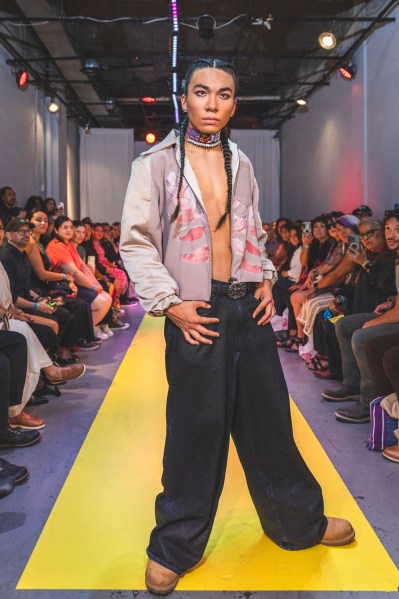
6
Warmichic
Born out of honoring the women who migrate from Peru’s rural provinces to Lima in search of better futures for their families Warmichic, meaning elegant woman in Quechua and French, was founded by designer Qarla Quispe to reimagine the pollera as both resistance and remembrance of courage in the face of discrimination and high rates of violence. As a second-generation migrant with family roots in Arequipa and Canta provinces, Quispe grew up confronting prejudice toward her Quechua surname and hearing jokes that mocked traditional dress. In response, she began designing stylish polleras for women in the city as an act of defiant cultural revival. Crafted from reused textiles, her designs embody circularity through embroidered illustrations of protests, biological motifs, and the women who inspire her. “I started positioning revered artisans who influenced me as equal to artists like Picasso and Dalí,” she explains. “When I was told they weren’t representative of art masters, I decided to lean even deeper into showing artisan iconography and techniques through my clothing.”
Down the runway, the polleras are styled with boots by Q’orilazo, meaning golden lasso which are a Peruvian take on Texas cowboy classics which also reference the horse-riding Peruvian vaqueros/as from the Chumbivilcas province in Cusco, Peru. Together they demonstrate an empowered Andean-feminine synergy. Quispe asserts, “it’s important that we occupy space held in the same regard as the established vanguard to say, this is who we are and here we are.”
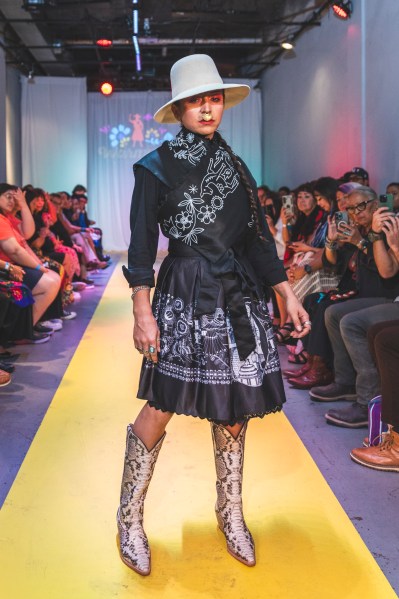
7
Matriaca Studio
Educated at FIT in knitwear and cut-and-sew, Matrica Studio’s designer Natalia Bermeo approaches fashion as emotional excavation. Her work is shaped by Ecuadorian heritage from the Cañari community of Azogues, and by the legacy of a family once devoted to weaving hats and artisanal designs. Addiction and loss fractured that lineage, with both grandparents who were proficient artisans having passed before she was born. This generational absence left her to reimagine matriarchal presence through form, texture, and abstraction.
In her collections, knits and polleras appear as reimagined garments freed from stigma. “When my family first moved to the U.S., losing their dress was the first step to assimilation, so through design I’m trying to recover those concepts and connect it to how continuity can be represented without boxing us in.” For Bermeo, each piece is labor-intensive and couture in spirit with the work becoming a space for memory, through reclamation and healing.
